
Conservators at the Perth Museum and Art Gallery in Scotland made a surprising discovery when they cracked open the coffin of a nearly 3,000-year-old mummy for the first time in a century.
Decorating the inside of the coffin were paintings of the Egyptian goddess Amentet.
“We had never had a reason to lift the whole thing so high that we could see the underneath of the trough and had never lifted the mummy out before and didn’t expect to see anything there,” Mark Hall, collections officer at Perth Museum and Art Gallery, told the Scotman. The mummy was donated to the museum back in 1936.
Ta-Kr-Hb, as the mummy is identified in hieroglyphics on the coffin, is believed to preserve the remains of a priestess or princess from Thebes. The paintings, which line the internal and external bases of the coffin trough, show Amentet, known as “She of the West” or “Lady of the West,” in her customary red dress.
The fragile artifact, which sustained damage at the hands of grave robbers and Victorian collectors, had been undergoing conservation ahead of a display at the new City Hall Museum in Perth in 2022.
Conservators have discovered previously unknown paintings inside the Egyptian mummy Ta-Kr-Hb, from the collection of the Perth Museum and Art Gallery, Scotland. Photo courtesy of the Perth Museum and Art Gallery, Scotland.
Ta-Kr-Hb was examined at the Manchester Royal Children’s Hospital in 2013, where a CT scan and x-ray revealed her chest and pelvis had been damaged after mummification. Experts are now working to stabilize the condition of the mummy and prevent further deterioration.
To help fund the project, which is expected to cost £16,608 ($20,329), the trust administering the region’s museums, Culture Perth and Kinross, has launched a JustGiving crowdfunding campaign. To date, it has raised £1,307 ($1,600) toward a goal of £7,395 ($9,053).
Conservators have discovered previously unknown paintings inside the Egyptian mummy Ta-Kr-Hb, from the collection of the Perth Museum and Art Gallery, Scotland. Photo courtesy of the Perth Museum and Art Gallery, Scotland.
“Although both the mummy and the coffin have suffered badly during the centuries in the tomb, from grave-robbers searching for amulets to flash floods that washed mud and debris onto the painted coffin,” project conservators Helena and Richard Jaeschke said in a statement, “they have survived remarkably well and need careful, patient conservation treatment to enable them to survive for many more years and allow everyone to see the beautiful paintwork on the coffin.”